In an interview with Hollywood.com,
producer Michael Uslan compared Joel Schumacher's Batman Forever (1995)
to the comics, saying:
"Batman Forever, to me, clearly was the Batman from about the mid-1940s till the early 1960s. It was Bill Finger’s scripts of Batman and Robin punching their way through crime through a grotesque gallery of supervillains, jumping across giant typewriters as they battle them."
Screenwriters Lee and Janet Scott Batchler have stated they read the
1939-1940 comics by Bob Kane and Bill Finger, the then contemporary
Knightfall story arc, and Frank Miller's The Dark Knight Returns
(1986) for inspiration.
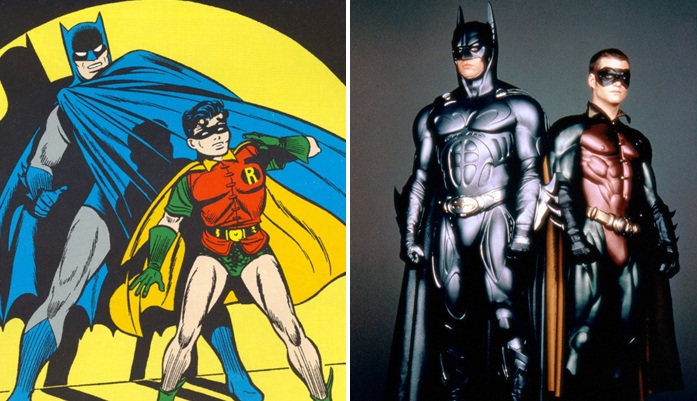
The influence of these stories is clearly
evident in the finished film. The movie also has many additional parallels with
other comics not cited by the filmmakers. Some of these are doubtless the
product of coincidence, but in this feature we're noting as many parallels as
possible in order to highlight the consistencies between Schumacher's movie and
the source material it adapts.
BATMAN FOREVER AND THE
COMICS
As in the comics, the Two-Face in the movie is
governed by fate. He uses a coin flip to determine the outcome of important
decisions. If the coin lands good side up, the old Harvey will spare his victim.
But if it's scarred side up, then the murderous side of his personality gets to
take over.
Two-Face's back story in the film is the same
as in the comics. He was formerly District Attorney Harvey Dent, scarred in
court when crime boss Sal Maroni hurled acid in his face. Batman tried to stop
Maroni, but failed to do so in time to help Dent. The physical and psychological
scarring resulted in him becoming Two-Face. The flashback in the movie where we
see this happen is exactly the same as the original scene from 'The Crimes of
Two-Face' (Detective Comics #66, August 1942).
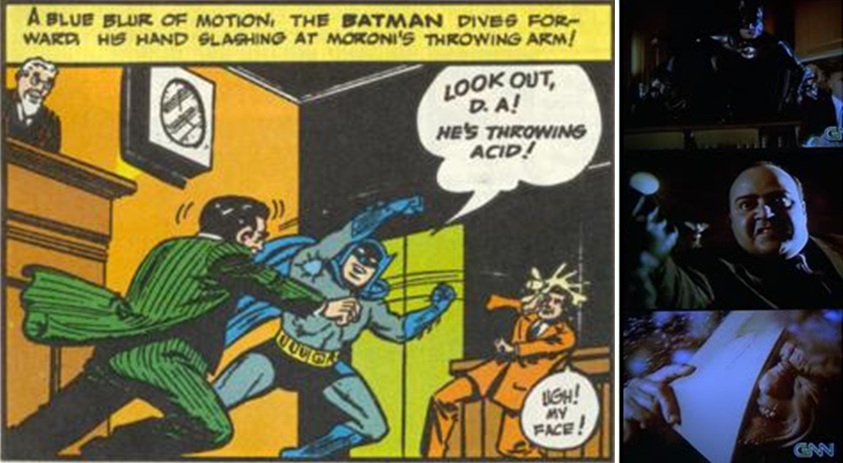
The look of Boss Maroni in the film also
matches his appearance in the comics. In this example from 'Free Faces'
(Detective Comics #563, June 1986), note how Batman grabs Maroni's arm
when he throws the acid, just like he does in the movie and Detective
Comics #66.
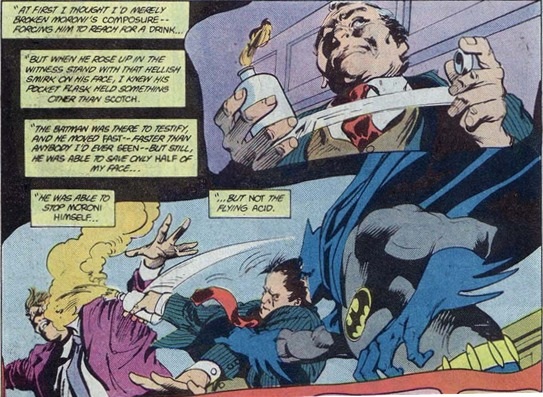
In the Golden Age comics there were actually
two Two-Faces. The first was Harvey Kent, who to all intents and purposes was
the same as the modern version of Two-Face. Kent was eventually cured, underwent
plastic surgery and resumed a happy normal life. He and his wife were even
guests at Bruce Wayne and Selina Kyle’s wedding, as were Clark and Lois Kent.
This highlighted the flaw of having two major DC universe characters called Kent
(the wedding story was even called ‘The Kill Kent Contract!’ and the plot
revolved around confusion as to which ‘Kent’ was targeted by the villain).
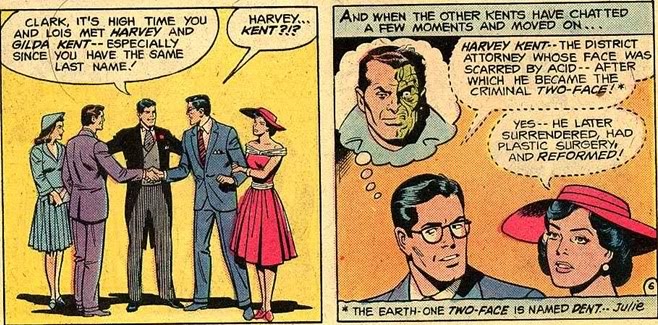
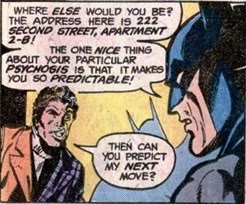 So from the Silver Age onwards Two-Face was renamed Harvey
Dent. The second Golden Age Two-Face was Paul Sloane, an actor who
sustained a similar injury to Kent and adopted his predecessor’s modus operandi
as his own.
So from the Silver Age onwards Two-Face was renamed Harvey
Dent. The second Golden Age Two-Face was Paul Sloane, an actor who
sustained a similar injury to Kent and adopted his predecessor’s modus operandi
as his own.
The movie begins with Two-Face robbing the
second bank of Gotham on the second anniversary of the day Batman captured him.
The first crime Two-Face ever pulled in the comics was also a bank robbery. He
traditionally commits crimes in accordance with a 2-motif. The robbery of the
second bank on the second anniversary of his capture is consistent with that
pattern.
In 'Eye of the Beholder' (Batman
Annual #14, 1990), Two-Face refers to himself in the first person plural.
He also does this throughout the movie.

Two-Face’s goons addressing him as "Face" is
likely a nod to Frank Miller’s The Dark Knight Returns
(1986).

As is the scene of Batman dangling from Two-Face’s helicopter.
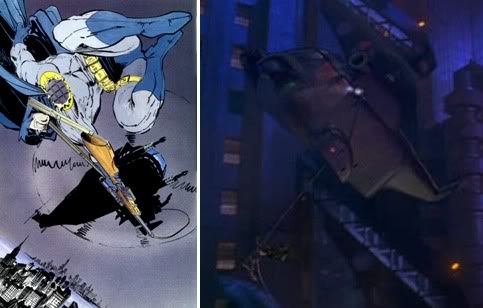
The scene of Batman hanging from the helicopter
could also be a reference to Marv Wolfman’s Batman: Year Three (1989).
This story took place in the wake of Jason Todd’s death and told, via
flashbacks, the origin story of Dick Grayson’s Robin. The opening action
sequence sees Batman hanging onto a rope attached to a helicopter in an
endeavour to capture its occupants. The Helicopter pilot tries to shake him off,
at one point attempting to swing him into a tower. The sequence ends with Batman
plunging into the waters of Gotham harbour while the villains escape.
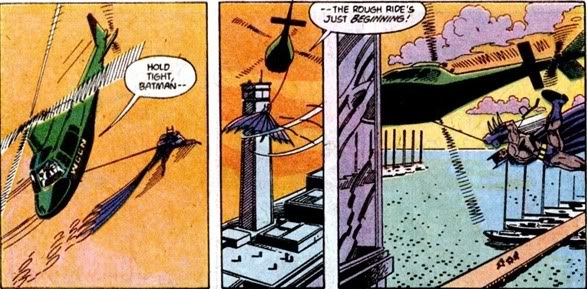
This scene is also visually similar to the cover of ‘Once Beaten, Twice Sly!’ (Batman #314, August 1979).
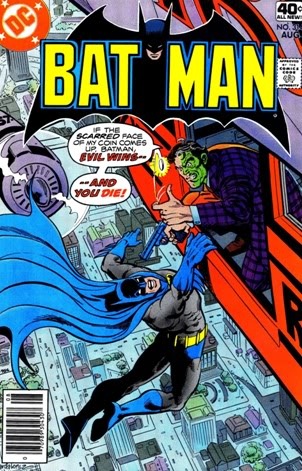 In the film, Two-Face tries to kill Batman by crashing the helicopter
into a statue bearing an uncanny resemblance to New York City’s Statue of
Liberty. The Gotham City of the comics has been shown to have a similar landmark
called ‘The Statue of Freedom’, as seen here in ‘Into the Den of the
Death-Dealers!’ (Detective Comics #411, May 1971
In the film, Two-Face tries to kill Batman by crashing the helicopter
into a statue bearing an uncanny resemblance to New York City’s Statue of
Liberty. The Gotham City of the comics has been shown to have a similar landmark
called ‘The Statue of Freedom’, as seen here in ‘Into the Den of the
Death-Dealers!’ (Detective Comics #411, May 1971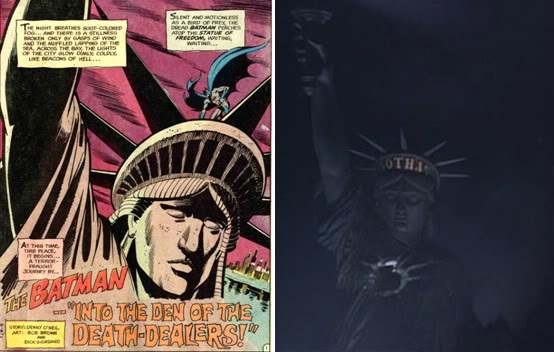 Two-Face's parachute is marked with a red and black yin-yang symbol.
This is more or less identical to the emblem on the side of Two-Face's dirigible
in Matt Wagner's Batman: Faces (1992).
Two-Face's parachute is marked with a red and black yin-yang symbol.
This is more or less identical to the emblem on the side of Two-Face's dirigible
in Matt Wagner's Batman: Faces (1992).
The next day Bruce Wayne sees the Bat-Signal in
the sky while he is at work. He quickly gets to the Batcave using a secret
tunnel linked to his office. When Bruce Wayne moved into his penthouse in the
seventies comics, he had a secret elevator linked to a subbasement of the Wayne
Foundation Tower that served as a secondary Batcave. This may have been the
inspiration for the tunnel in the movie.
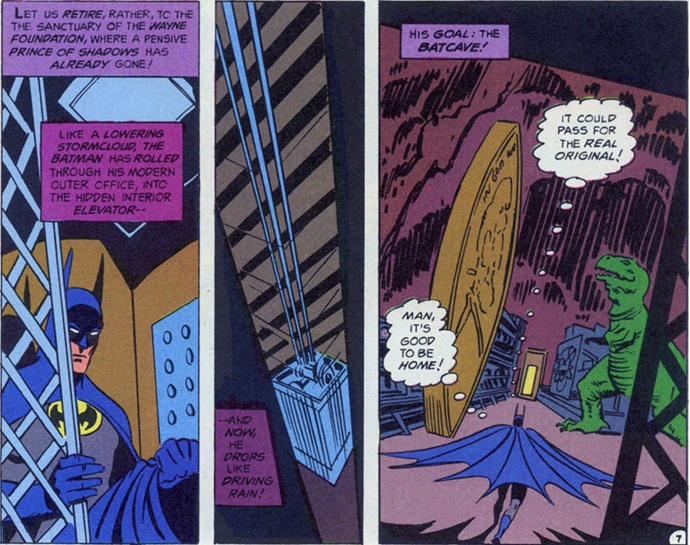
Batman races to police headquarters, only to
find that it is Chase who has summoned him. This scenario, where a woman misuses
the signal to summon Batman for her own purposes, also happened in ‘Hot House’
(Legends of the Dark Knight #42, February 1993).
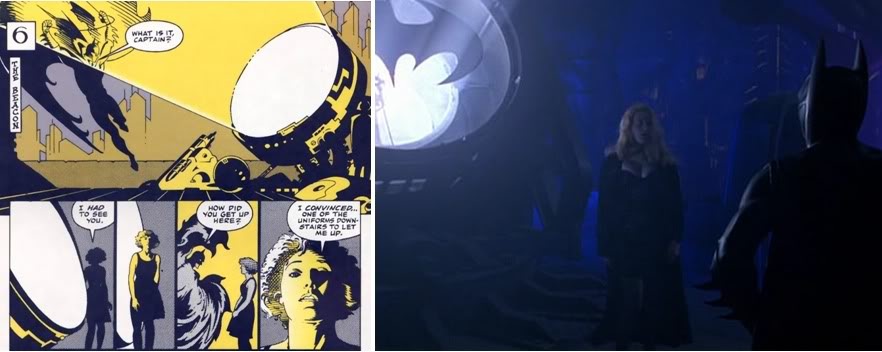
Elsewhere, Edward Nygma is embarking on his own
criminal career. His origin story in this movie – revolving around his desire to
get revenge against his former employer – is reminiscent of his origin in
Batman: The Animated Series, as told in the episode ‘If You’re So
Smart, Why Aren’t You Rich?’
Nygma ties up his supervisor, Fred Stickley,
using green rope. In the Riddler’s debut story – ‘The Riddler’ (Detective
Comics #140, October 1948) – he ties up one of his victims using special
puzzle rope.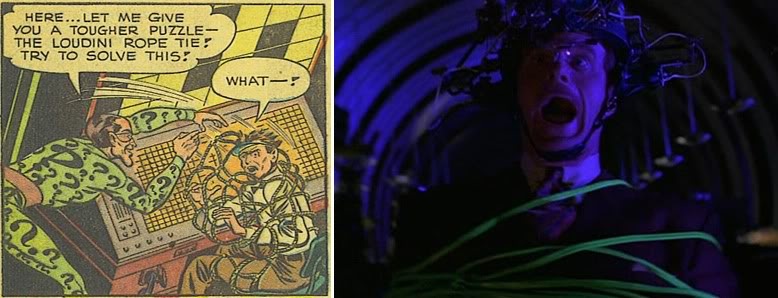 We also hear him say "Riddle me this..." for the first time in this
scene. The Riddler in the comics often says this before proposing his latest
conundrum.
We also hear him say "Riddle me this..." for the first time in this
scene. The Riddler in the comics often says this before proposing his latest
conundrum.
 We also hear him say "Riddle me this..." for the first time in this
scene. The Riddler in the comics often says this before proposing his latest
conundrum.
We also hear him say "Riddle me this..." for the first time in this
scene. The Riddler in the comics often says this before proposing his latest
conundrum.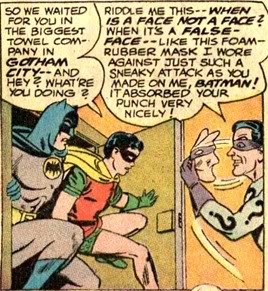
Nygma then proceeds to send Bruce Wayne a series of riddles pieced together from newspaper clippings.
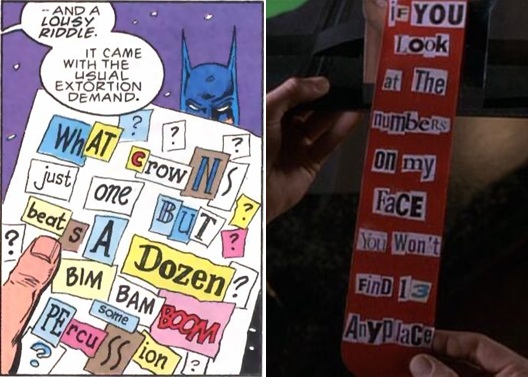

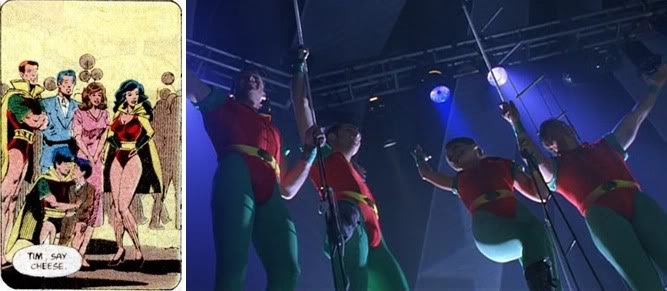
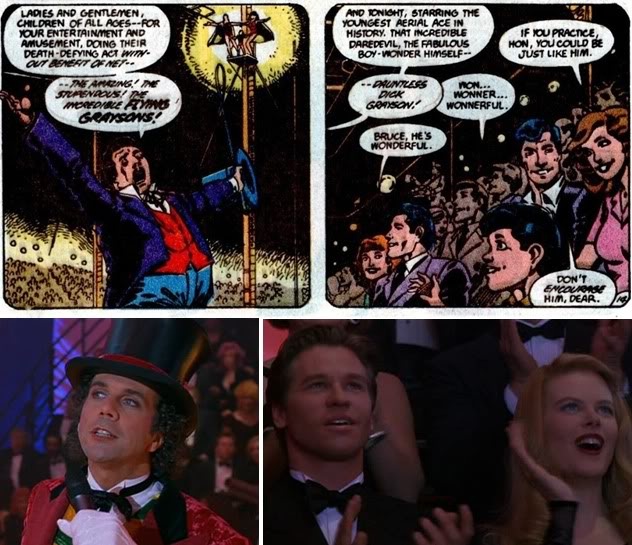
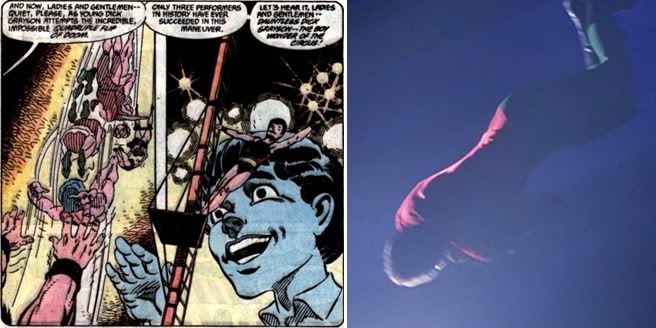

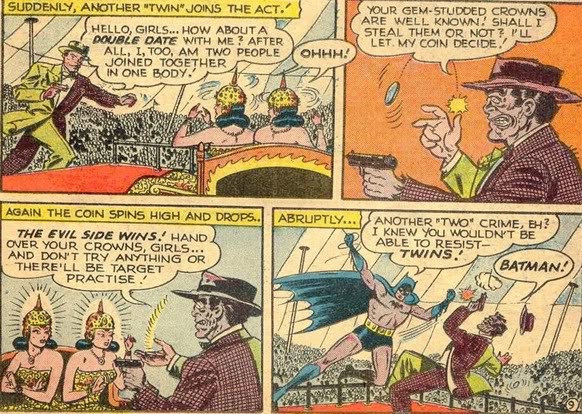

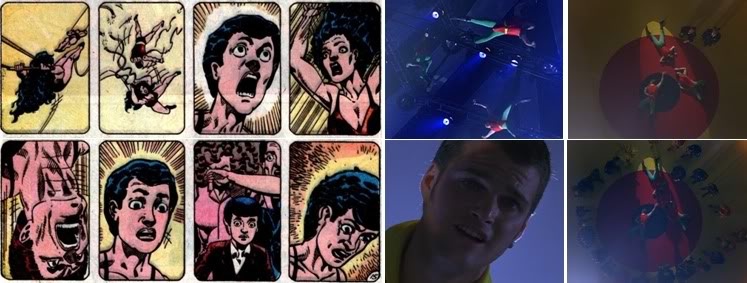
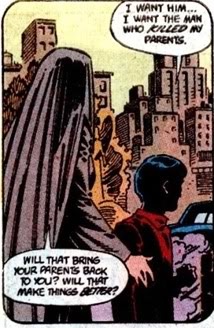
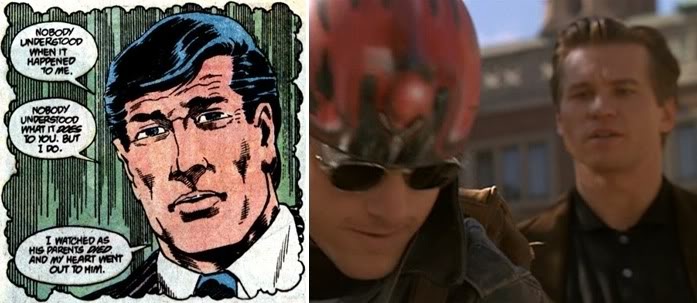
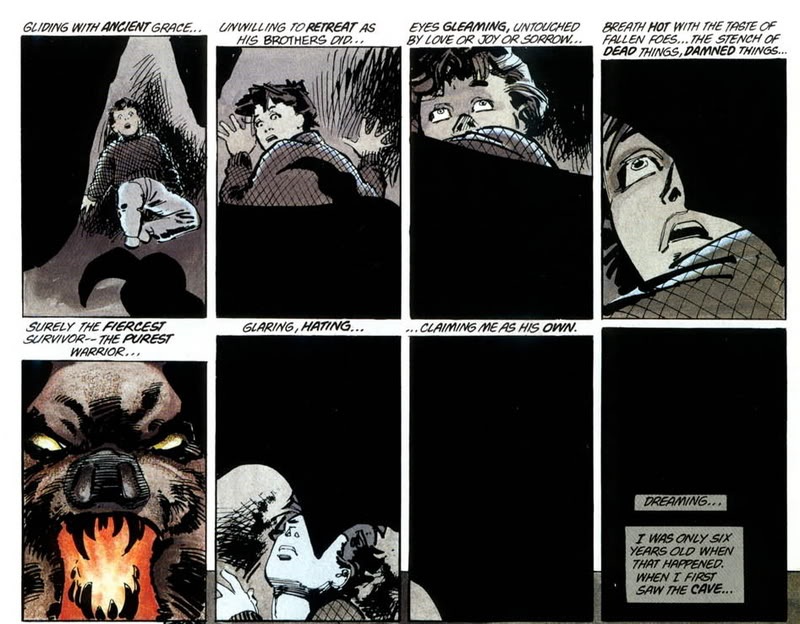
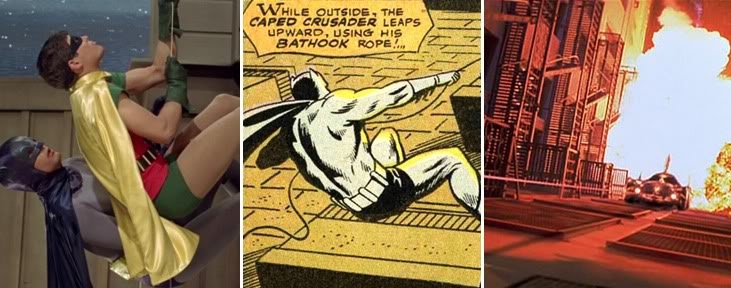
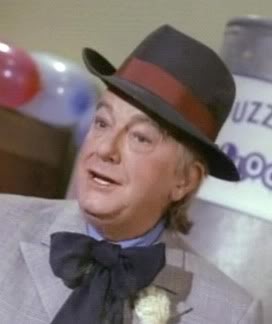 Back at Nygma’s apartment, he tries to concoct an appropriate
costumed identity for himself. In doing so he considers several different
monikers under which he might operate. These include the Puzzler, the Gamester,
Captain Kill and Question Mark Man. Some of these are pre-existing characters
Back at Nygma’s apartment, he tries to concoct an appropriate
costumed identity for himself. In doing so he considers several different
monikers under which he might operate. These include the Puzzler, the Gamester,
Captain Kill and Question Mark Man. Some of these are pre-existing characters
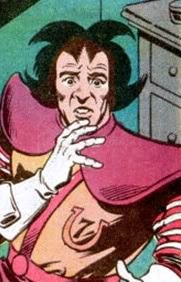 But it’s more likely this is a reference to a similarly-named villain
created for the Adam West Batman TV show. During the second season, Riddler
actor Frank Gorshin was in a legal dispute with the producers. This left the
production crew with several scripts that’d already been written for the
Riddler, but no actor to play the role. One of the solutions they came up with
was to create a new villain – the Puzzler (played by Maurice Evans, pictured
left)) – and rewrite the scripts to accommodate him.
But it’s more likely this is a reference to a similarly-named villain
created for the Adam West Batman TV show. During the second season, Riddler
actor Frank Gorshin was in a legal dispute with the producers. This left the
production crew with several scripts that’d already been written for the
Riddler, but no actor to play the role. One of the solutions they came up with
was to create a new villain – the Puzzler (played by Maurice Evans, pictured
left)) – and rewrite the scripts to accommodate him.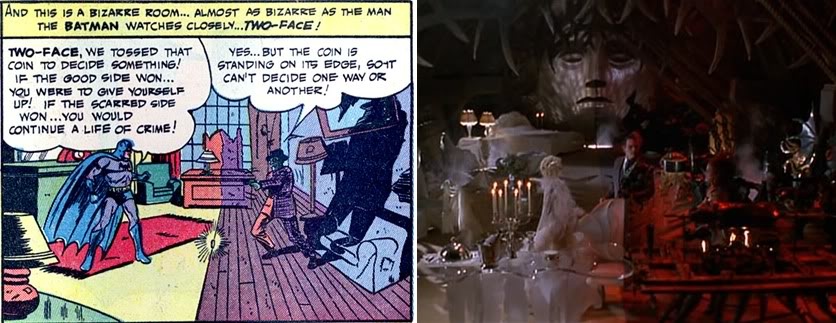
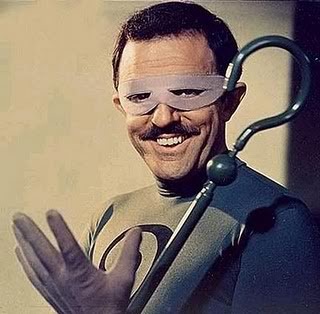
No comments:
Post a Comment